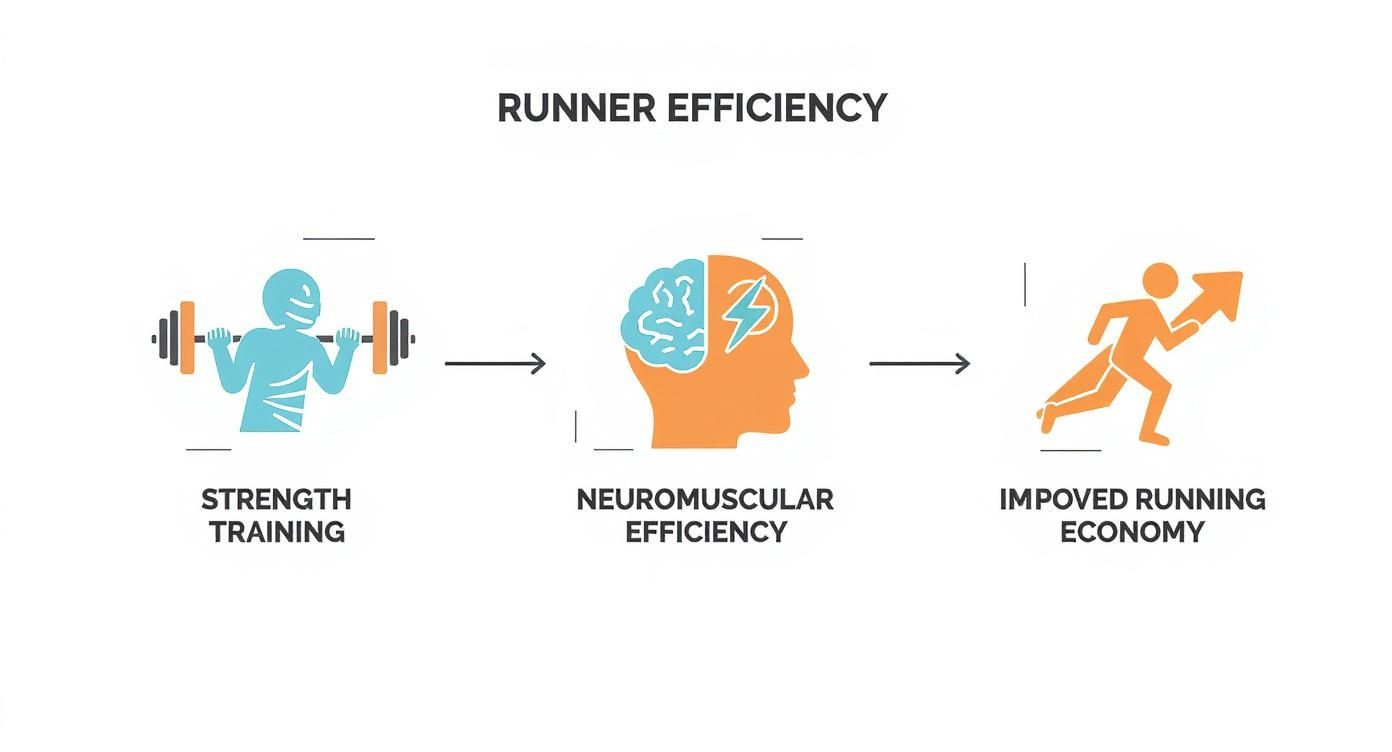strength training for distance runners: boost your pace
- Flourish Everyday Health And Fitness

- 8 hours ago
- 10 min read
It’s a common myth in the running world: to get faster, you just need to run more. But what if the key to your next PR isn't just on the pavement, but in the weight room?
Many runners fear that lifting will make them bulky and slow them down. In reality, a smart strength training for distance runners program is one of the most powerful tools for building a more durable, efficient, and faster running body. This isn't about becoming a bodybuilder. It's about building a stronger, more resilient engine to power your endurance. By strengthening the key muscles that drive you forward, you create a system that can better handle the relentless pounding of thousands of foot strikes, mile after mile.
Index of Sections
Unlocking Your True Running Potential
The Real Science Behind Strength and Endurance
Building Your Runner-Specific Strength Plan
Essential Strength Exercises for Peak Performance
How to Fit Lifting Into Your Running Schedule
Common Strength Training Mistakes Runners Make
Your Top Strength Training Questions, Answered
References

Unlocking Your True Running Potential
The benefits of a good lifting routine go beyond just getting stronger; they directly impact your running performance in several key ways.
Improved Running Economy: This is your body's version of fuel efficiency. Strength work helps your muscles generate more force with less oxygen, meaning you can hold your pace with less effort.
Injury Resilience: Running is a high-impact sport. Strengthening the muscles, tendons, and ligaments around your hips, knees, and ankles provides crucial support and stability.
Increased Power and Speed: A stronger posterior chain (glutes, hamstrings, and calves) leads to a more explosive stride, which translates to faster finishing kicks and more power on hills.
A comprehensive scientific review found that heavy and explosive strength training gives trained runners a small but significant boost in running economy, typically in the 1–3% range (Balsalobre-Fernández, Santos-Concejero, & Grivas, 2016). Over a half marathon or marathon, this can make a massive difference. Consistent strength work is your best defense against common overuse injuries. For a deeper dive, check out our guide on how to prevent running injuries with top tips for safe running.
How Strength Training Directly Impacts Your Running
Benefit | Impact on Running Performance | Primary Goal |
|---|---|---|
Improved Running Economy | Run faster at the same effort level or hold a pace longer with less fatigue. | Increase force production without needing more oxygen. |
Enhanced Injury Resilience | Reduces the risk of common overuse injuries like runner's knee, IT band syndrome, and shin splints. | Strengthen muscles and connective tissues to better absorb impact. |
Increased Power & Speed | Develop a stronger finishing kick and improve your ability to surge or tackle hills. | Boost neuromuscular coordination for more explosive strides. |
Better Biomechanics | Helps you maintain proper running form, even when you're tired late in a race. | Corrects muscular imbalances that lead to form breakdown. |
The Real Science Behind Strength and Endurance
The goal of strength training for distance runners isn't to build large muscles, but to improve running economy—your body's miles-per-gallon. Better economy means you can hold a faster pace using less oxygen and energy.
Think of your muscles and nerves as a circuit. Strength training, especially with heavy loads and explosive movements, upgrades this system. It trains your brain to send stronger, more coordinated signals, activating more muscle fibers with each command. This improved neuromuscular wiring means each footstrike packs more punch with less wasted energy. Your VO2 max may stay the same, but your ability to use that oxygen gets a serious boost.
The Neuromuscular Advantage
Lifting heavy or performing plyometrics teaches your body to generate maximum force quickly. This conditions your muscles and tendons to become "stiffer" in a beneficial way, creating a powerful spring-like effect with every stride. This extra stiffness allows your tendons to store and release more energy, much like a pogo stick, reducing the workload on your muscles and delaying fatigue. This leads to shorter ground contact time and a more powerful push-off. To learn more, see our guide on what is strength and conditioning and how it boosts athletic performance.
Which Training Styles Deliver Real Results
Not all gym work is equal for runners. To achieve these neuromuscular upgrades, you must apply the right kind of stress. Research consistently points to a few highly effective methods.
High-Load Training: Lifting heavy (e.g., 3-5 reps of squats or deadlifts) is proven to enhance neuromuscular efficiency.
Plyometric Training: Explosive movements like jumps train your muscles to produce force rapidly, which directly translates to more power on the run.
Combined Training: A smart mix of heavy lifting and plyometrics often yields the most significant gains in running economy.
Conversely, science shows that submaximal training—lighter weights for high reps—and long isometric holds don't significantly benefit already fit runners (Piacentini et al., 2023). The most effective strategy combines heavy loads and explosive movements to rewire your system for efficiency. You can explore more research on these training methods on PubMed.
Addressing the Fear of Unwanted Bulk
Many runners worry that lifting will make them bulk up and slow them down. This fear is understandable but unsupported by science for endurance athletes. The type of strength training beneficial for runners—heavy weight, low reps—stimulates neural adaptations, not significant muscle growth (hypertrophy). Furthermore, the high volume of cardio from distance running creates a physiological environment that naturally limits muscle bulk. Studies show that when endurance athletes add a proper strength routine, they rarely see significant changes in body composition.
Building Your Runner-Specific Strength Plan
It's time to build a strength plan that works with your running, not against it. The key is to sync your strength training with your running calendar, a practice known as periodization. This means your lifting will vary between your off-season and your peak marathon training block.
Structuring Your Workouts By Season
Your strength plan should mirror the phases of your running year to provide the right stimulus at the right time without causing burnout.
Off-Season/Base-Building: This is your prime time to get strong. With lower running mileage, your body can handle more in the weight room. Focus on lifting heavier in the 4-6 rep range for your main compound lifts.
Pre-Competition/Peak Training: As running volume increases, shift your gym sessions into maintenance mode. You've built the strength; now you just need to keep it. Drop the volume and focus on 2-4 reps with heavy, explosive movements to keep your neuromuscular system sharp without excessive soreness.
Race Phase/Taper: In the final 1-2 weeks before a major race, back off significantly. Light bodyweight circuits or mobility work are fine, but heavy lifting is off the table. The priority is arriving at the start line fresh and recovered.

Defining Frequency, Volume, and Intensity
For most runners, 2-3 strength sessions per week on non-consecutive days is the sweet spot. This provides enough stimulus for adaptation with ample recovery time. During peak race season, one or two focused sessions may be sufficient to maintain gains.
The best bang for your buck comes from compound, multi-joint movements. Forget bicep curls; exercises like squats, deadlifts, and lunges are superior because they recruit large muscle groups and build functional power that mimics running demands. A typical workout should include 2-3 sets per exercise, with rep ranges adjusted based on your season. For intensity, choose a weight that is challenging but allows for perfect form. The final reps should be tough, but not at the expense of technique.
Essential Strength Exercises for Peak Performance
A smart strength training for distance runners plan strengthens the entire system that powers your stride, from your core to your upper back. Focusing on big, compound movements builds functional strength that improves performance and reduces injuries.

Foundational Lower Body Movements
Your legs are your engine. These exercises build the raw power and stability needed to handle thousands of footstrikes. We'll use bilateral movements for pure strength and unilateral (single-leg) work to correct imbalances.
Squats: The king of lower-body strength, building power in your glutes, quads, and hamstrings. Focus on keeping your chest up and sinking your hips back and down.
Deadlifts: Your secret weapon for a stronger stride. It targets the entire posterior chain—glutes, hamstrings, and lower back—which is your powerhouse for propulsion. A flat, neutral spine is essential for safety.
Bulgarian Split Squats: This single-leg exercise is excellent for identifying weaknesses. By elevating your back foot, you isolate one leg, challenging your balance and exposing strength discrepancies.
For more exercise options, see our guide on the top resistance training exercises to unleash your strength.
The Runner's Strength Training Cheat Sheet
Exercise | Target Muscles | Benefit for Runners |
|---|---|---|
Squats | Glutes, Quads, Hamstrings | Builds the raw leg power needed for hill climbs and finishing kicks. |
Deadlifts | Posterior Chain (Glutes, Hamstrings, Back) | Increases stride power and helps maintain a strong, upright posture. |
Bulgarian Split Squats | Glutes, Quads, Core | Corrects muscle imbalances and improves single-leg stability for a more efficient stride. |
Plank | Entire Core (Abs, Obliques, Back) | Creates a rigid torso to prevent energy waste and protect the spine. |
Pallof Press | Obliques, Transverse Abdominis | Fights rotational forces, keeping you running in a straight, efficient line. |
Pull-Ups / Lat Pulldowns | Lats, Upper Back, Biceps | Promotes an upright posture, which opens up your chest for better breathing. |
Inverted Rows | Rhomboids, Mid-Traps | Counters the runner's slouch, pulling shoulders back for better form. |
Push-Ups | Chest, Shoulders, Triceps, Core | Builds upper body and core endurance to maintain arm drive and posture when fatigued. |
Core Work for Unshakeable Stability
A strong core is the bridge between your legs and upper body. It acts as a stabilizing platform, preventing energy leaks and helping you maintain form when fatigued.
Plank: A classic that teaches your entire core to brace and protect your spine.
Pallof Press: A must-do anti-rotation exercise that trains your obliques to resist twisting forces during your stride.
Bird-Dog: Challenges coordination by requiring you to maintain a flat back while extending opposite limbs, targeting deep stabilizing muscles.
Functional Upper Body Exercises for Better Form
Your upper body plays a key role in posture and arm swing. A strong back and shoulders prevent slouching, which keeps your chest open for easier breathing.
Pull-Ups (or Lat Pulldowns): Builds strength in your lats and upper back, crucial for an upright running posture.
Inverted Rows: The perfect antidote to the runner's forward lean, strengthening the muscles that pull your shoulder blades back.
Push-Ups: A full-body exercise that builds chest, shoulder, and triceps strength while demanding serious core engagement, reinforcing good running posture.
How to Fit Lifting Into Your Running Schedule
When should you lift? A poorly timed session can leave your legs feeling heavy, but a smart schedule can make you feel unstoppable. The goal is to integrate strength training for distance runners so it supports your running. One of the most effective philosophies is to keep your hard days hard and your easy days truly easy. This means doing your lifting on the same day as your toughest runs, like a track workout or tempo run.
The Hard Days Hard Approach
This strategy consolidates stress into a single 24-hour window, allowing the following day to be a true recovery day. By stacking a tough run and a lift on the same day, you give your body a real chance to adapt. A common method is to do your key run in the morning and lift in the afternoon, allowing a few hours for refueling and rest. This approach protects your easy days, ensuring they remain dedicated to recovery.
Alternative Scheduling Strategies
Lifting on Easy Run Days: For some, pairing a lift with an easy run works. Keep the run genuinely easy and leave several hours between the run and the lift.
Dedicated Lifting Days: If your schedule allows, having a day solely for strength training can be effective, especially during the off-season when mileage is lower.
Putting It Into Practice: A Runner's Week
Example Week: Marathon Peak Season (Hard Days Hard)
Day | Activity |
|---|---|
Monday | Easy Run (4-6 miles) |
Tuesday | Hard Day: Track Workout AM / Strength Session PM |
Wednesday | Recovery Run (3-5 miles) |
Thursday | Hard Day: Tempo Run AM / Strength Session PM |
Friday | Rest or Cross-Train |
Saturday | Long Run (16-20 miles) |
Sunday | Recovery Run (3-5 miles) |
Example Week: Off-Season (Base Building)
Day | Activity |
|---|---|
Monday | Easy Run (5 miles) |
Tuesday | Strength Session (Focus on heavy lifts) |
Wednesday | Moderate Run with Strides |
Thursday | Strength Session (Focus on heavy lifts) |
Friday | Easy Run (5 miles) |
Saturday | Long-ish Run (8-10 miles) |
Sunday | Rest or Active Recovery |
Ultimately, the best schedule is one you can maintain consistently. Listen to your body, and don't neglect proper fueling and sleep, which are crucial for handling the combined stress.
Common Strength Training Mistakes Runners Make
To ensure your gym time translates to better running, avoid these common traps.
One of the biggest errors is focusing on the wrong exercises. Isolation movements like bicep curls don't provide the same benefit as compound exercises like squats and deadlifts, which build functional, full-body power. Another major pitfall is inconsistency. Two consistent sessions per week are far more effective than an erratic, all-out approach that leads to burnout or injury.
Mismanaging Intensity and Expectations
Going too heavy too soon is a classic mistake. Your tissues need time to adapt. Piling on weight before mastering form is a fast track to injury. It's also vital to have realistic expectations. Strength work improves performance metrics, but the link to race times isn't always direct.
For instance, one study found that while 21 weeks of strength training significantly improved collegiate athletes' jump height and balance, there was no direct correlation between these specific gains and their cross-country race times (Trowell et al., 2020). This doesn't negate the value of strength training; it simply highlights that the primary benefits are often improved running economy and reduced injury risk, rather than a predictable drop in your 5K time. You can view the study on neuromuscular gains and race performance.
Your Top Strength Training Questions, Answered
Here are quick answers to the most common questions about strength training for runners.
How Many Days a Week Should a Distance Runner Lift Weights?
For most runners, 2-3 non-consecutive days per week is the sweet spot. This provides enough stimulus for strength gains without compromising recovery. During a peak training block, you might reduce this to one or two maintenance sessions. Consistency is key.
Will Strength Training Make Me Bulky and Slow?
This is the biggest myth holding runners back. The type of strength training for distance runners we advocate—heavy lifts for low reps—builds neural strength and efficiency, not muscle size (hypertrophy). Paired with high-volume running, getting bulky is extremely difficult. The goal is to become stronger and more resilient, not bigger.
Can I Do Strength Training and Run on the Same Day?
Yes, this is an effective way to structure your week. Lifting a few hours after a hard run consolidates stress, allowing for better recovery on easy days. If you must do them back-to-back, run first to keep your legs fresh for your primary sport. Listen to your body and find a schedule that works for you.
References
Balsalobre-Fernández, C., Santos-Concejero, J., & Grivas, G. V. (2016). Effects of Strength Training on Running Economy in Highly Trained Runners: A Systematic Review With Meta-Analysis of Controlled Trials. Journal of Strength and Conditioning Research, 30(8), 2361–2368.
Piacentini, M. F., La Torre, A., Lacasella, G., et al. (2023). Effects of a combined strength, power, and plyometric training in elite middle- and long-distance runners. Frontiers in Sports and Active Living, 5.
Trowell, D., Vicenzino, B., Saunders, N., et al. (2020). The effect of a 21-week, in-season strength-training program on the physical characteristics of collegiate cross-country runners. International Journal of Sports Physiology and Performance, 15(8), 1144-1151.
Here at Flourish-Everyday, our commitment is to give you the best, most practical information to help you on your fitness journey. We believe in a balanced approach that brings together endurance, strength, and overall wellness. To get the right gear and more expert advice to fuel your training, check us out at https://www.flourish-everyday.com.
Comments